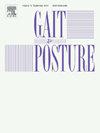贝克肌萎缩症对步态模式的影响:来自生物力学分析的见解
IF 2.2
3区 医学
Q3 NEUROSCIENCES
引用次数: 0
摘要
目前对肌营养不良的研究主要集中在早发性杜氏肌营养不良(DMD)。然而,对晚发病的贝克肌营养不良症(BMD)患者的步态特征的研究仍然有限,特别是那些16岁以后诊断的患者。迟发性症状可能破坏先前建立的步态模式,可能导致独特的代偿机制和临床结果。研究问题本研究旨在探讨16岁以后出现症状的BMD患者的步态特征和足底压力分布。方法选取16岁以后确诊的男性骨密度病患者7例,健康男性对照10例。采用统计非参数映射(SnPM)分析步态运动学和动力学的变化,测量足底压力,计算对称角(SA)。结果bmd患者在站立期(StP)表现出更大的骨盆前倾和髋关节屈曲增加,并且在StP早期出现较高的髋关节伸展力矩峰值,在StP早期出现膝关节过伸和膝关节伸展力矩不足,在摇摆期出现较高的膝关节屈曲,在StP结束时出现持续的踝关节背屈。足底压力在足跟处增加,而内侧和外侧跖骨区以及拇趾和小脚趾的压力明显降低。SA结果显示对非优势腿施加更大压力的倾向。16岁以后出现症状的bmd患者表现出与部分DMD患者相似的步态代偿模式,但踝关节行为存在明显差异,值得进一步研究。足底压力分布可作为评估疾病进展的潜在临床指标本文章由计算机程序翻译,如有差异,请以英文原文为准。
Impact of Becker muscular dystrophy on gait patterns: Insights from biomechanical analysis
Background
Current research on muscular dystrophy primarily focuses on Duchenne muscular dystrophy (DMD) with early onset. However, studies on gait characteristics in Becker muscular dystrophy (BMD) patients with later onset, particularly those diagnosed after the age of 16, remain limited. The late onset of symptoms may disrupt previously established gait patterns, potentially leading to unique compensatory mechanisms and clinical outcomes.
Research question
This study aims to investigate gait characteristics and plantar pressure distribution in BMD patients with symptom onset after the age of 16.
Methods
Seven male BMD patients diagnosed after the age of 16 and ten healthy male controls were recruited. Changes in gait kinematics and kinetics were analyzed using statistical nonparametric mapping (SnPM), plantar pressure was measured, and symmetry angles (SA) were calculated.
Results
BMD patients exhibited greater anterior pelvic tilt and increased hip flexion during the stance phase (StP), along with higher peak hip extension moments in the early StP, knee hyperextension and insufficient knee extension moments in the early StP, higher knee flexion during the swing phase, and sustained ankle dorsiflexion at the end of the StP. Plantar pressure was increased at the heel, while pressures in the medial and lateral metatarsal regions, as well as the hallux and lesser toes, were significantly lower. SA results indicated a tendency to apply greater pressure on the non-dominant leg.
Significance
BMD patients with symptom onset after the age of 16 exhibit gait compensation patterns similar to those observed in some DMD patients, with distinct differences in ankle joint behavior that warrant further investigation. Plantar pressure distribution may serve as potential clinical indicators for assessing disease progression
求助全文
通过发布文献求助,成功后即可免费获取论文全文。
去求助
来源期刊

Gait & posture
医学-神经科学
CiteScore
4.70
自引率
12.50%
发文量
616
审稿时长
6 months
期刊介绍:
Gait & Posture is a vehicle for the publication of up-to-date basic and clinical research on all aspects of locomotion and balance.
The topics covered include: Techniques for the measurement of gait and posture, and the standardization of results presentation; Studies of normal and pathological gait; Treatment of gait and postural abnormalities; Biomechanical and theoretical approaches to gait and posture; Mathematical models of joint and muscle mechanics; Neurological and musculoskeletal function in gait and posture; The evolution of upright posture and bipedal locomotion; Adaptations of carrying loads, walking on uneven surfaces, climbing stairs etc; spinal biomechanics only if they are directly related to gait and/or posture and are of general interest to our readers; The effect of aging and development on gait and posture; Psychological and cultural aspects of gait; Patient education.
 求助内容:
求助内容: 应助结果提醒方式:
应助结果提醒方式:


